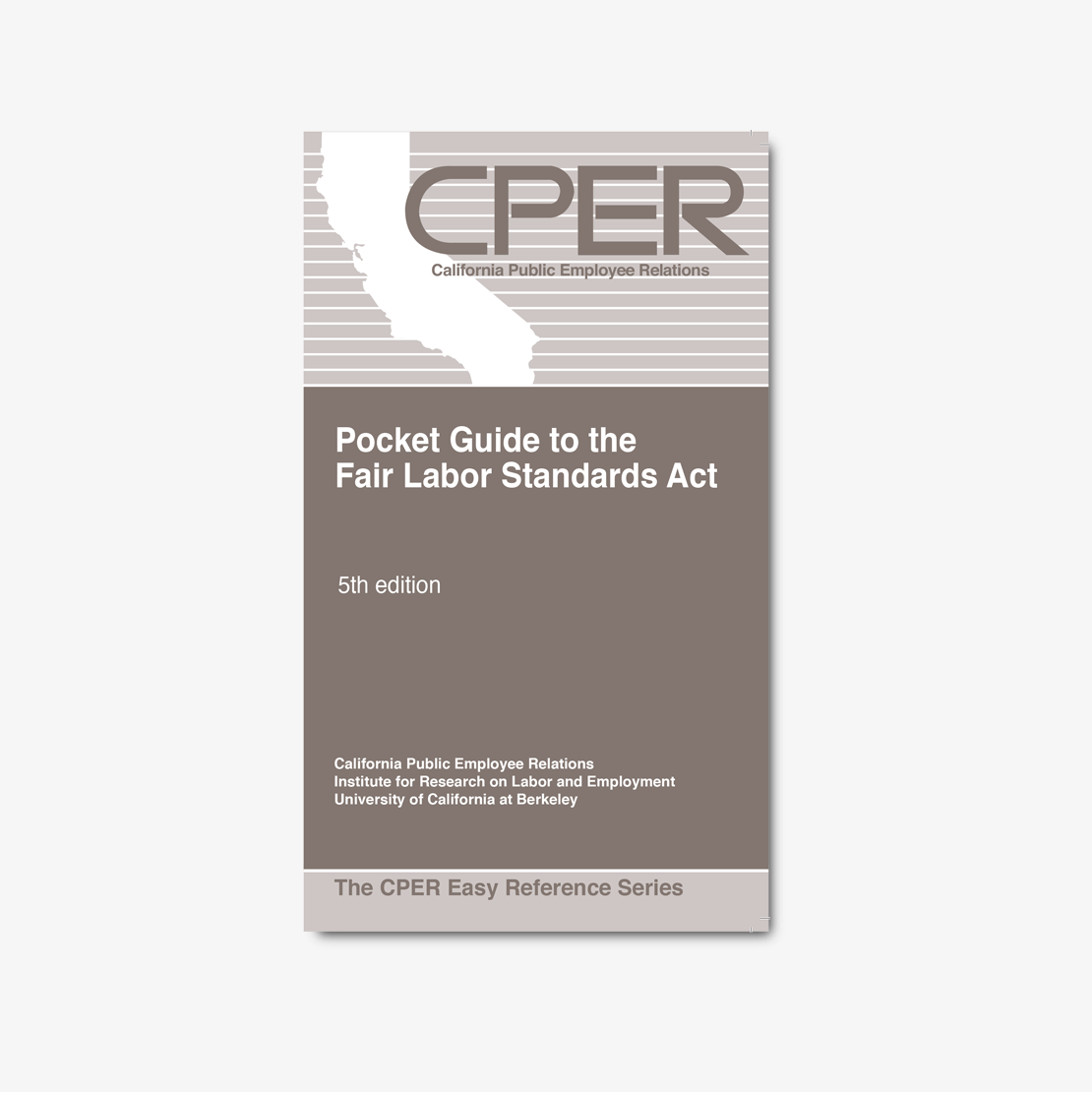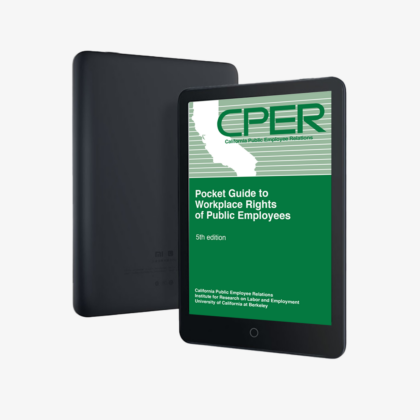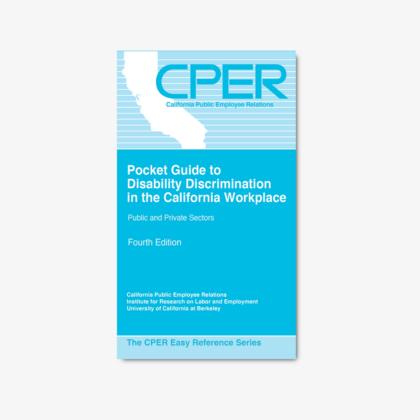This Pocket Guide replaces the 2017 4th edition. CPER’s FLSA guide focuses on the Act’s impact in the public sector workplace and explains complicated provisions of the law that have vexed public sector practitioners, like the “salary basis” test and deductions from pay and leave for partial-day absences.
Each chapter tackles a broad topic by providing a detailed discussion of the law’s many applications in special workplace environments. For example, the chapter that covers overtime calculation begins by defining regular rate of pay and then considers the payment of bonuses, fluctuating workweeks, and alternative work periods for law enforcement and fire protection employees. Other chapters focus on record keeping requirements, hours of work, and “white collar” exemptions. In each case, detailed footnotes offer an in-depth discussion of the varied applications of the FLSA.
About the Authors
Coauthor Edmund “Deak” Brehl served as labor relations counsel for the California Department of Personnel Administration, in Sacramento. The DPA represents state agencies in all aspects of labor law before administrative agencies and in the state and federal courts. Coauthor Cathleen A. Williams is an attorney in private practice in Sacramento. She specializes in FLSA cases on behalf of employees and unions. This edition was updated by Brian Walter, a partner with the law firm of Liebert Cassidy Whitmore, which represents public agency management in all aspects of labor and employment law, including labor relations, civil litigation and education. Walter regularly advises and counsels in all areas of employment and labor law, including the FLSA. He conducts FLSA audits for clients, represents clients in DOL and DLSE audits, and presents FLSA trainings. He is a member of the Editorial Advisory Board for Thompson Publishing Group’s Fair Labor Standards Handbook for States, Local Governments and Schools. Charbonneau represents public employers in FLSA and other employment litigation, as well as advises on FLSA audits, FLSA compliance efforts, and other labor and employment law subjects. Review attorney Christopher Platten is a partner with Wylie, McBride, Platten & Renner in San Jose.
Table of Contents
- Overview (Page 1)
- History of the FLSA in the Public Sector (Page 1)
- The Department of Labor’s FLSA Regulations (Page 4)
- DOL regulations (Page 5)
- DOL interpretative bulletins and letter rulings (Page 5)
- State Wage and Hour Law (Page 6)
- Exclusions From FLSA Coverage (Page 7)
- Exclusions for Elected Officials, Their Staff, and Certain Employees of Legislative Bodies (Page 7)
- Statutory exclusion (Page 7)
- Criteria for each excluded class (Page 8)
- Independent Contractors (Page 9)
- The DOL’s ‘totality of circumstances’ test (Page 9)
- Trainees (Page 10)
- Volunteers (Page 11)
- Permissible payments and benefits (Page 11)
- Current employees cannot volunteer to perform the same or similar services (Page 13)
- Total Exemption for Small Fire and Police Departments (Page 14)
- Prison Inmates (Page 14)
- Case Studies on FLSA Coverage (Page 15)
- Exclusions for Elected Officials, Their Staff, and Certain Employees of Legislative Bodies (Page 7)
- Overtime Exemptions (Page 17)
- The White Collar Exemption (Page 17)
- The salary test (Page 17)
- The duties test (Page 23)
- Exemption for Highly Compensated Employees (Page 31)
- Application of Exemptions to First Responders (Page 32)
- Computer Employee Exemption (Page 32)
- Recreational Establishment Exemption (Page 33)
- Case Studies on Overtime Exemptions (Page 34)
- The White Collar Exemption (Page 17)
- The Work Period (Page 36)
- Definition of Workweek (Page 36)
- Requirement to designate (Page 36)
- Requirements regarding change of workweeks (Page 37)
- The 7(b) Work Period (Page 37)
- The 26-week/1,040-hour work period (Page 37)
- The 52-week/2,080-hour work period (Page 38)
- The Hospital 7(j) Work Period (Page 39)
- Public Safety 7(k) Work Periods (Page 39)
- Fire protection activities (Page 38)
- Law enforcement activities (Page 42)
- Twenty-percent limitation on nonexempt work (Page 43)
- Case Studies on the Work Period (Page 43)
- Definition of Workweek (Page 36)
- Hours Worked (Page 45)
- Distinction Between Paid Leave Time and Actual Hours Worked (Page 45)
- Volunteer Work Time (Page 46)
- Recording and Rounding Small Amounts of Time (Page 46)
- Substitute Work for Another Employee (Page 47)
- Employees Working in More Than One Position for the Same Employer (Page 48)
- Definition of ‘occasional or sporadic’ (Page 48)
- Definition of work ‘in a different capacity’ (Page 48)
- Special rule for law enforcement (Page 48)
- Special rule for teaching activities (Page 49)
- Special rule for court reporters employed by a public entity (Page 49)
- Waiting Time (Page 50)
- On-Call and Stand-By Time (Page 50)
- Factors regarding ability to engage in personal pursuits (Page 51)
- Rest Periods (Page 52)
- Meal Periods (Page 53)
- Meal periods for public safety personnel on a 7(k) work period (Page 53)
- Sleep Time (Page 54)
- Duty of less than 24 hours (Page 54)
- Duty of 24 hours or more (Page 55)
- Sleep periods for 7(k) police and fire personnel (Page 55)
- Pre- and Post-Shift Activities (Page 55)
- Travel to and from work (Page 56)
- Travel Time (Page 57)
- Travel to and from work (Page 57)
- Travel during the workday (Page 57)
- Overnight travel (Page 58)
- Training Time (Page 58)
- Definition of voluntary attendance (Page 59)
- Definition of training directly related to employee’s job (Page 59)
- Training required for certification by a higher agency (Page 59)
- Independent training (Page 60)
- Employer-sponsored training and education programs (Page 60)
- Apprenticeship training programs (Page 60)
- Work at Home (Page 60)
- Employees who reside on employer premises or work at home (Page 60)
- K9 cases (Page 61)
- Cleaning and maintenance of motorcycles and trucks (Page 62)
- Grievance Processing Time (Page 62)
- Early Relief (Page 63)
- Off-Duty Special Detail Work (Page 63)
- Medical Treatment for Employees (Page 64)
- Case Studies on Hours Worked (Page 64)
- Compensatory Time Off Under the FLSA (Page 68)
- Distinction Between FLSA CTO and Non-FLSA CTO (Page 68)
- Employer and Employee Must Agree That CTO Compensation Is Permissible (Page 69)
- Represented employees (Page 69)
- Unrepresented employees (Page 69)
- CTO Accruals (Page 69)
- Public safety activities (Page 70)
- Emergency response activities (Page 70)
- Seasonal activities (Page 70)
- Use of Accumulated FLSA CTO (Page 71)
- ‘Reasonable period’ (Page 71)
- ‘Unduly disrupt’ (Page 71)
- Forced use of CTO (Page 71)
- No standards for use of non-FLSA CTO (Page 72)
- Payment for Accumulated FLSA CTO (Page 72)
- Penalties for Violation of the FLSA CTO Provision (Page 73)
- Case Studies on CTO (Page 73)
- Regular Rate of Pay (Page 74)
- Calculation of the Regular Rate of Pay (Page 75)
- The hourly employee (Page 75)
- Employees paid on a basis other than hourly (Page 75)
- 7(k) work period employees (Page 76)
- Fixed Wages for Fluctuating Hours (Page 76)
- The Regular Rate for Employees at More Than One Rate of Pay (Page 76)
- Weighted average method (Page 77)
- Rate for the position in which overtime work is performed (Page 77)
- Payments Excluded From Regular Rate of Pay (Page 77)
- Payments Included in Regular Rate of Pay (Page 79)
- Timely Payment of Wages (Page 79)
- Case Studies on the Regular Rate of Pay (Page 80)
- Calculation of the Regular Rate of Pay (Page 75)
- Minimum Wage (Page 82)
- Newly Hired Employees Under 20 Years Old (Page 82)
- Recordkeeping (Page 83)
- General Recordkeeping Requirements for Employees (Page 83)
- Records Required for Hospital Employees Working a 7(j) Work Period (Page 85)
- Records Required for Employees Working a 7(b) Work Period (Page 85)
- DOL Posting Requirements (Page 86)
- Preservation of Records (Page 86)
- Remedies and Enforcement (Page 87)
- Statute of Limitations (Page 87)
- Damages Available to Employees (Page 87)
- Immunity From Suits by Private Persons (Page 88)
- Table of Cases (Page 90)




